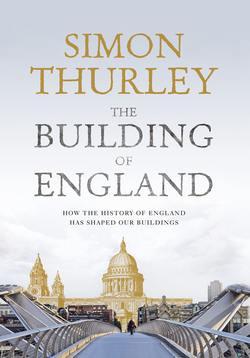Читать книгу The Building of England: How the History of England Has Shaped Our Buildings - Simon Thurley - Страница 16
The Anglo-Saxon Church
ОглавлениеThe importance of churches to Anglo-Saxon society cannot be overestimated. Whilst kings were mobile, their buildings only occasionally utilised, and their economic effects dispersed, churches were rooted to a single location and thus became centres of economic activity and often, in due course, the kernel of towns. Minster churches also needed land to support them, and Church land, unlike the land owned by aristocrats, was not transferable between generations but held in perpetuity. The amassing of land by the Church contributed to a shift in focus from movable wealth, a feature of Germanic societies, to the idea of permanent land holding, as in Roman times. Land transactions were thus increasingly recorded and legalised, and the landscape divided and packaged.
In addition to landed endowments, often provided by royal or aristocratic patrons, relics, pilgrimages and miracles were the trinity that underpinned the building economy and design of the medieval church. For Saxons, relics had supernatural power. They were placed inside altars, carried into battle, used for solemnising oaths; without them no church was able to function. The more famous the relic, the greater the chance of attracting pilgrims who would make gifts of money at the shrines they visited. But pilgrimage was not only a pious act; it was a visual education for the clergy, builders and the laity. It was the cause of mobility and design exchange, of competition and of rising architectural expectation.7 Even modest numbers of pilgrims set architectural problems for church designers. People needed to be able to come close to relics in an orderly and controlled way that enabled suitable donations to be made, and satisfaction with the experience to spread by word of mouth.
One of the most conspicuous innovations connected with pilgrimage was the crypt, a small underground chamber, normally under the high altar, designed to contain relics. It was the crypt at St Peter’s, Rome, that established this feature as an aspiration for any late Saxon church. Brixworth (fig. 16) originally contained a ring crypt that allowed pilgrims to move round the apse, venerating relics, and the mausoleum at Repton was appropriated as a shrine to St Wystan, a royal prince murdered in 849. For this, a new access was cut, providing a proper circulation for pilgrims (fig. 15). Visitors to Repton and the surviving Anglo-Saxon crypts at St Andrew’s, Hexham, and at Ripon Cathedral can still explore the mysterious and gloomy subterranean circulation designed to lubricate the flow of pilgrims.
If the need to provide access to relics above and below ground was a fundamental factor in the design of the Anglo-Saxon church, so was the Saxon view of the Eucharist. Whilst Christ was obviously the focus for worship, it was the consecrated bread – the host – itself, as a sort of super-relic, that was venerated. Inside chapels the host could be placed on an altar alongside other relics, forming an easily multiplied supernatural focus. Because the moment of consecration was less important than the veneration of the host, Saxon churches were not as focused as later medieval churches on a single altar at the east end. Rather they comprised an assemblage of compartments on several floors, each with its own ritual focus. The most common and flexible of these subdivisions was the porticus, which served as side chapel, tomb chamber, sacristy or viewing chamber. The most important and impressive was the westwork,8 an enlargement of the west end of a church to provide a location for relics or shrines, a western choir, or occasionally a high-status viewing place (p. 46). These secondary spaces became progressively more important with a rise in the doctrine of purgatory and the appropriation of individual chapels by the rich for prayers to be said on their behalf. They also appealed to aristocratic aesthetic sense, which tended to the more ornamental, decorative and intricate than the big and bold.9
Before the 670s Christians did not expect to be buried in or near churches but were buried, like pagans, in cemeteries. By the late 7th century, however, the Church had wrested control of burial rites from friends and neighbours, and started to bury the dead close to Church buildings. Burial within churches themselves remained controversial and was made available only to individuals of the highest status. By 850, however, Christian cemeteries were serving large numbers of ordinary people, taking in land that was increasingly walled or fenced and populated by grave markers.
